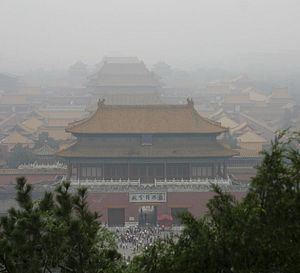Earlier this month, a team of Chinese Ministry of Environmental Protection (MEP) officials were on a routine inspection of a chemical factory in Beijing when a factory boss shuttered the exit and trapped the officials inside. The inspectors were locked in the building for more than an hour, and the story made headlines as yet another example of the challenges China faces as it scrambles to clean up its skies.
Following three years of air quality improvement, toxic smog in the Beijing area worsened over the first five months of 2017. While long-term air quality improvements are dependent on a transition away from coal and heavy industry, industry compliance is key to meeting this year’s targets. Yet meeting the 2017 targets is an increasingly daunting task, as local officials evade anti-emissions regulations and industries cling to outdated modes of production.
In many municipalities, local officials have failed to comply with efforts to reduce emissions. Following a recent inspection, Tianjin, Tangshan, and five other cities were named and shamed for failing to draft and enforce practicable anti-pollution action plans. Moreover, lists of industrial emissions sites are frequently far from comprehensive — according to the MEP, more than 30 sites each were omitted from lists compiled by local officials in Shijiazhuang, Xingtai, and Liaocheng municipalities. In some cases, the standards for what constitutes “high emissions” are questionable. In Puyang, Henan Province, breakfast shops were listed among businesses to be shut down due to high emissions.
These instances of noncompliance occur because local officials continue to prioritize short-term objectives over long-term environmental benefits. While provincial and local governments should be responsible for upholding these policies, low incentives for reaching environmental targets discourage them from doing so. Local authorities often avoid confrontations with industry, instead invoking concerns about the short-term economic impact of environmental compliance.
Yet industries themselves are ultimately at fault for their own noncompliance. In the first quarter of 2017 alone, 3,119 out of 8,500 factories inspected in the Beijing-Tianjin-Hebei area were cited for violations, including off-limit discharge, unrecorded emissions, and data tampering and falsifying.
Rather than taking responsibility for their emissions, polluters often adhere to outdated conceptions of environmental accountability. Companies hedge their bets that they can avoid emissions citations based on sheer luck, or even deception. In early April, MEP inspectors found that employees at Baoshan Cement Company in Shandong Province had manually shrunk an exhaust pipe detection area, causing emissions readings to differ significantly from actual concentrations. At Fuhaixin Steel Company, a plume detector was deliberately closed to prevent data uploading.
Industries often fall back on the excuse that mandatory environmental policies such as installing filters and scrubbers are too costly for plants that are barely making ends meet. Finding a solution to this problem requires taking a step back — rather than requiring costly upgrades that permit outdated, highly polluting industries to scrape by, shutting down plants that cannot meet emissions standards in a financially viable way would boost environmental compliance and accelerate the clean energy transition.
Since 2012, when public outrage over air pollution erupted online, the government has enacted and revised a series of laws and action plans, which have formed a strong initial framework for pollution reduction. These include the Action Plan for Air Pollution Prevention and Control (2013-2017), and revisions to the Environment Protection Law, Air Pollution Prevention and Control Law, and Environment Impact Assessment Law.
The MEP has also taken steps to increase the cost of non-compliance for industries. The recently released Environmental Pollution Discharge Permit framework standardizes the inspection process by setting emission limits for each industry and outlining monitoring protocol. Under the revised system, industries, rather than inspectors, are responsible for ensuring compliance and are tasked with recording and reporting their own emissions data. In addition, the “Daily Penalty” clause of the Environmental Protection Law increases the penalty for violations that go unaddressed; fines are now multiplied by the number of days that a violation occurs.
But much more action is needed to meet the 2017 targets. Compliance can be increased by further strengthening penalties for violators, upping the frequency of unannounced inspections, and ensuring that emissions data is both accurate and available for review by third party organizations, such as NGOs. In the long term, the importance of moving away from outdated, high-emissions industries cannot be overlooked. Increased emissions compliance and a transition toward renewable energy must be implemented in parallel to ensure that wintertime blue skies are no longer an anomaly.
Yang Yi is a campaigner at Greenpeace East Asia. Her work is focused on emissions policy and compliance.

































